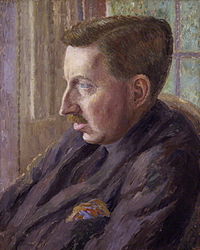Review: 'A Room With a View' by E.M. Forster
 My topic in English this year is 'Love Through The Ages', which means I am allowed to re-read books such as 'Pride & Prejudice' and 'Jane Eyre' and call it school work. One of the books I had to read that was new to me though was 'A Room With A View' by E.M. Forster.
My topic in English this year is 'Love Through The Ages', which means I am allowed to re-read books such as 'Pride & Prejudice' and 'Jane Eyre' and call it school work. One of the books I had to read that was new to me though was 'A Room With A View' by E.M. Forster.It was published in 1908 at the beginning of the so called Edwardian Era, which followed the Victorian period. The latter was a very repressive era, whereas the Edwardian period was much more about self-exploration and independence, especially for women. In this book Forster shows these opposing social ideals and how they influence a young woman called Lucy Honeychurch.
The story is separated into 2 "books". The first is set in Florence, where Lucy is doing a Grand Tour, and the second in England, where she lives. A Grand Tour was usually reserved for men, but that changed in the Edwardian period and Lucy went to Florence to expand her cultural knowledge. She is accompanied by Ms. Bartlett, who is somewhat of a spinster. She represents the Victorian values in the book, always telling Lucy how to behave and what to do. Lucy has completely accepted this and seems almost void of any actual feelings, until she meets George Emerson, a working class young man.
 Forster beautifully crafts their affection for each other in such a way that we as a reader know exactly what is going on but that we can also see Lucy's confusion at these ne feelings she does not understand. His use of language, especially when describing nature is beautiful. Forster has been known and criticized for his love for symbolism. I very much enjoyed it, because it meant he spent enough time on description, which many books lack. Also, his characters formed perfect oppositions to each other. The two Emersons seemed so free and wise in our eyes, whereas Ms. Bartlett and Cecil seemed old-fashioned and aged.
Forster beautifully crafts their affection for each other in such a way that we as a reader know exactly what is going on but that we can also see Lucy's confusion at these ne feelings she does not understand. His use of language, especially when describing nature is beautiful. Forster has been known and criticized for his love for symbolism. I very much enjoyed it, because it meant he spent enough time on description, which many books lack. Also, his characters formed perfect oppositions to each other. The two Emersons seemed so free and wise in our eyes, whereas Ms. Bartlett and Cecil seemed old-fashioned and aged.The love story is a truly typical one, but executed in such a way you are never quite sure whether what you are expecting will actually happen. Therefore the end is both surprising and gratifying as a reader. Forster even wrote an appendix for his novel because he felt he wanted to share what he thought would happen to his characters after the novel finished.
All in all, this is a truly enjoyable book, even though it needs some getting into. His characters are funny, especially the way they talk about each other, and he describes Florence in such a way that I cannot wait to go travel there myself. I do think that perhaps Forster should have been less severe on Ms. Bartlett. Although he does redeem her in the end, we despise her throughout the largest part of the novel.
I give this book...

5 UNIVERSES!!!
Despite being harsh on some characters, Forster brilliantly describes the clash between two different periods and different schools of thinking. His skill in symbolism and imagery is stunning and creates pages of writing that are fascinating to read.



I loved this review! This would be a keeper book for anyone.
ReplyDelete